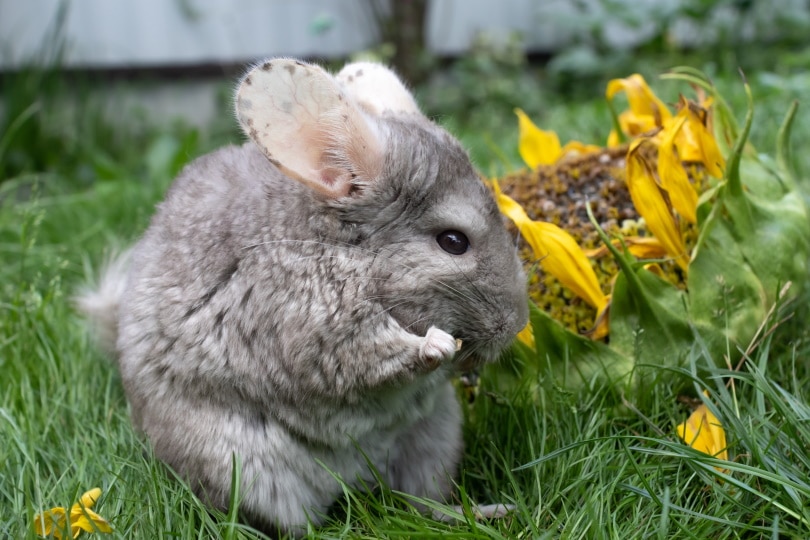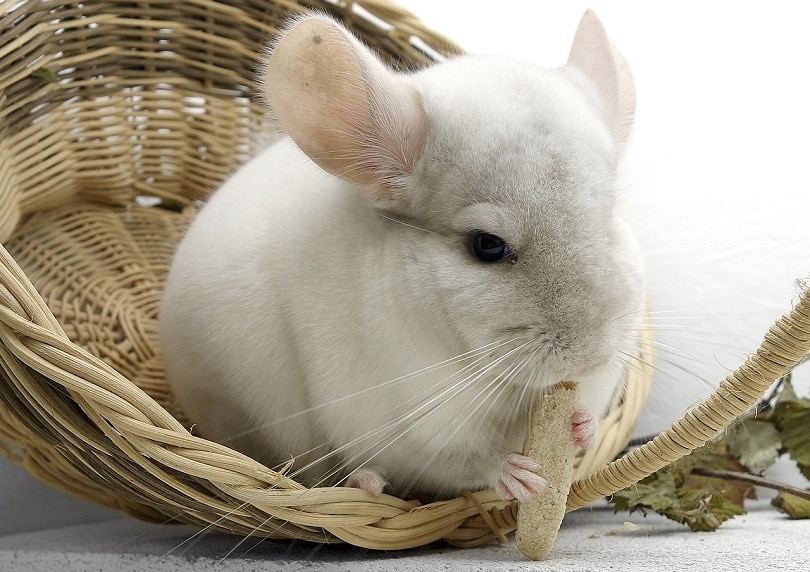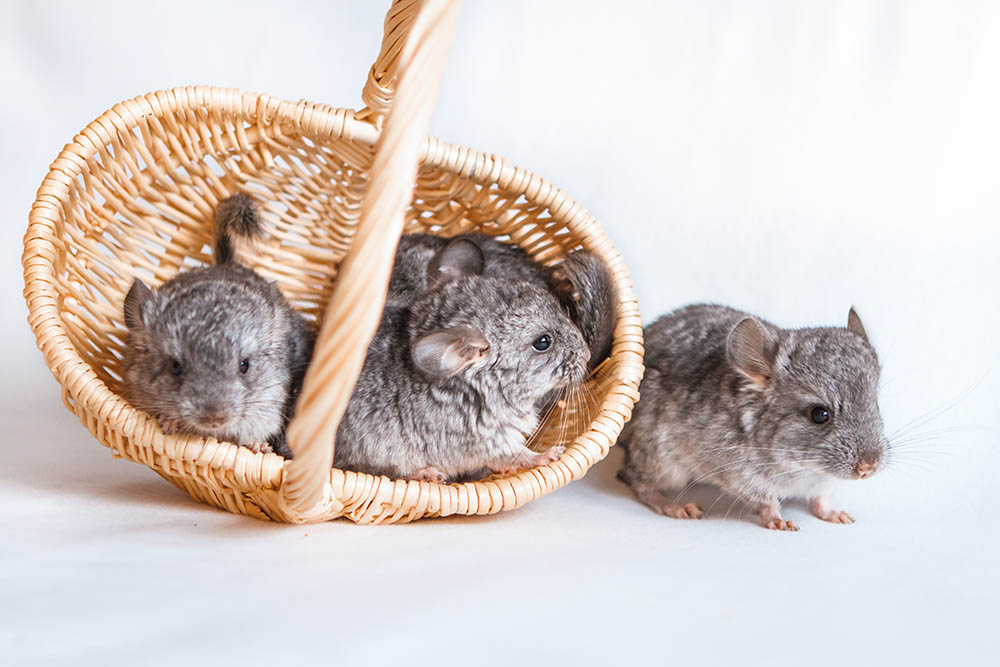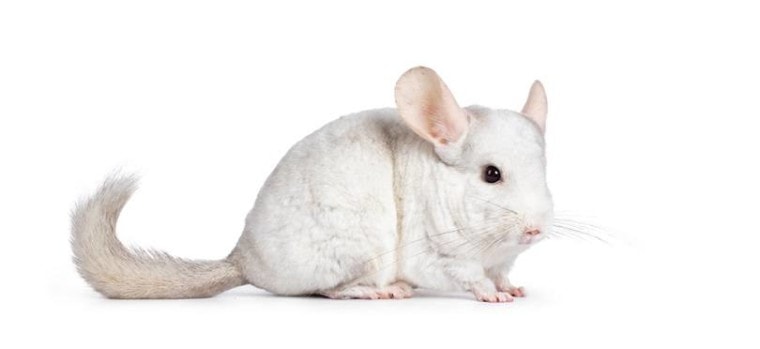
| Height: | 10-12 inches |
| Weight: | 370-490 grams |
| Lifespan: | 13-20 years |
| Colors: | Grey, white, brown |
| Temperament: | Gentle, quiet, curious |
| Suitable For: | Apartments, households without cats |
There are two types of Chinchillas: long-tailed and short-tailed. There are differences between the two in their personality and physical characteristics. These little animals are classified as rodents and happen to be one of the biggest in their species.
Chinchillas as pets have been increasing in popularity over the last decade. They are clean animals and odorless, a pleasant change from some other remarkably stinky rodents. They are soft and have adorably large ears and big black eyes. The most crucial factor to consider before buying a Chinchilla is that they can live for up to two decades, making them a long-term commitment.
Long-Tailed Chinchillas — Before Bringing One Home..

What’s the Price of Long-Tailed Chinchillas?
It is highly recommended to avoid buying a Chinchilla from a pet store because of how likely they were caught, bred, or provided to the store. From a breeder or a rescue organization for Chinchillas, you will be spending between $150 and $350.
Chinchillas are a relatively low-maintenance pet, and their monthly costs demonstrate this. It is enough to budget about $20 per month to cover the cost of their food, dust, hay, and litter, along with toys. The start-up cost when you get your first Chinchilla will also include the basics, like a cage.
3 Little-Known Facts About Long-Tailed Chinchillas
1. Long-tailed Chinchillas come from Chile in high elevations.
There are many commercially bred long-tailed Chinchillas for the domesticated pet market. However, in nature, Chinchillas have been hunted practically until extinction. Wild Chinchillas are currently considered an endangered species by the IUCN. Their numbers are low and only continue to decline.
Long-tailed Chinchillas are native to the Andes Mountains in Northern Chile. There are currently only two known colonies of Chinchillas that remain. The region that these Chinchillas live in is cold and quite arid because it is above the tree line. They naturally thrive in areas of elevation between 9,800 to 16,000 feet, or 3,000 to 5,000 meters.
2. A Chinchilla can have up to 50 individual hairs per single follicle.
Chinchillas are perfectly designed for the grueling areas that they call home. They have incredibly dense coats of soft fur. Each follicle can contain up to 50 hairs, keeping these little animals warm no matter the temperature in those sky-high peaks.
The softness and density of the Chinchilla’s fur is the reason that they have become endangered. Upon their discovery by tradesmen in the 1900s, the sport and business of hunting a Chinchilla became popular.
Their pelts were prized, at their height going for $100,000 per coat of Chinchilla fur. Unfortunately for these little creatures, it took 100 pelts to produce one fur coat.
Nowadays, there have been laws instated in Chile to protect long-tailed Chinchillas. These laws state that neither the native animals nor their fur can legally be traded internationally. But since Chinchillas frequently inhabit areas that are quite remote, it is difficult to enforce these laws, and poaching still occurs.
3. Although Chinchillas are loving pets, they don’t like to be held.
Chinchillas tend to form deep bonds with their humans over their lifespan of a couple decades. However, since they have wild animal still in them, they do not prefer to cuddle. Their coats are also so dense that they can quickly overheat, so being held close to you probably won’t feel comfortable for them.
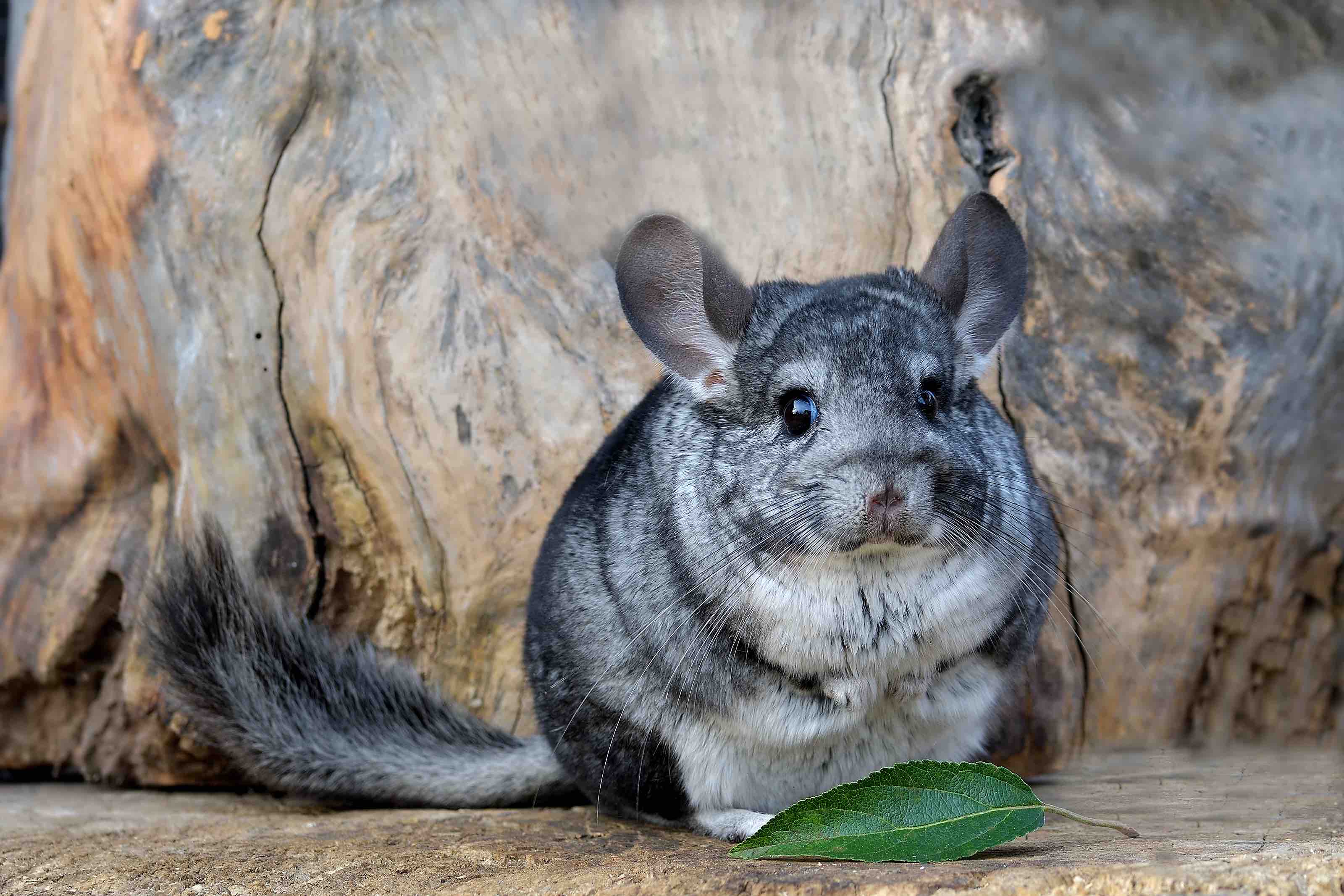
Temperament & Intelligence of the Long-Tailed Chinchilla
The Chinchilla is an exciting pet because of their highly social and intelligent personalities. Although they are nocturnal, these little creatures like to be quite active and will prefer to only be awake from dusk until dawn.
Chinchillas are smart enough that they quickly learn to recognize their names. As they bond with their owners, they will easily recognize the difference between them and any other human around. If you introduce someone new to them, do it slowly and carefully because they can be territorial. They are gentle, though. They are highly unlikely to bite unless they feel threatened, and even then, their bite is not dangerous.
Are These Pets Good for Families? 👪
Chinchillas are good pets for families. It is best to teach your kids how to interact with Chinchillas safely, though. They might not realize that they are hurting or scaring the Chinchilla if they are a new kind of pet. Chinchillas are usually friendly, though.
Does This Breed Get Along With Other Pets?
In the wild, long-tailed Chinchillas live in groups of up to 100 of their species. They are highly social, and it is best if you have one Chinchilla to get another for companionship. It is also best to acquaint them with each other slowly because they can be territorial. Since they are so small, they will often look like prey to cats and dogs and should be protected from these other pets.

Things to Know When Owning a Long-Tailed Chinchilla
Food & Diet Requirements 🥕
Long-tailed Chinchillas have a sensitive digestive system that needs a particular diet to maintain. It is best to give your Chinchilla dry grass because they would typically eat this in the wild. They need a large amount of fiber to keep their digestive system functioning well.
They also need plenty of protein and vitamin C to keep them in tip-top shape. It is best to supplement their diet with a rabbit mix to get them everything they need. You can also find Chinchilla food in pet stores or online.
Give them pellets rather than a mix because they are likely to pick out their favorite bits in a mix, which will lead to an unbalanced diet. Also, give them a supply of high-quality hay as a gut balancer. Put it in a small trough in their cage, and refill it every day.
Exercise 🐹
Since Chinchillas are nocturnal, they are bound to sleep for most of the day. They start to become active in the early hours of the evening. Before you go to bed, take them out for a run around the house. Be sure to supervise them because they are quite curious and can chew on wires if not watched.
Chinchillas have strong back legs that are built for jumping. As they warm up to their habitat, they are fun to watch bounce around the house. They can jump high enough to even get on top of places like the refrigerator. Allow them out for at least 30 minutes to an hour, so they don’t get restless or gain too much weight.
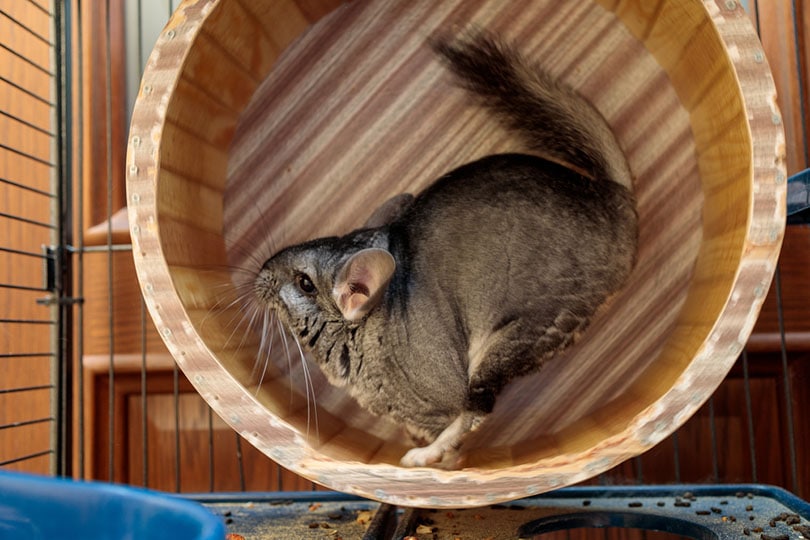
Training 🎾
Training a Chinchilla is mostly down to getting them accustomed to being handled by humans. You will need to do this slowly, enticing them to you with raisins or similar treats. Don’t overdo it on the treats, though, or they will get sick. Try to gently stroke them under their chin, allowing them to feel at ease with you.
While training a Chinchilla, watch out for signs that they feel frightened. They will stand up on their back legs and spray urine at those whom they believe are threats. If you handle them too roughly, they begin to shed handfuls of fur. You should never pick up a Chinchilla by the tail, but you can use it to keep them stable in your hands.
Grooming ✂️
Never bath a long-tailed Chinchilla with water. Their fur is so dense that it can take them days to dry off completely. This is enough time for them to get cold and sick. Instead, get a dust box for Chinchillas and put special, fine dust in the bottom.
Offer them a bath at least once a day for about 20 minutes. Leaving it with them too long might allow it to become too dirty, and they won’t want to use it again.
Check a Chinchilla’s eyes after a dust bath. Sometimes, dust can build up and cause eye problems if left for too long.
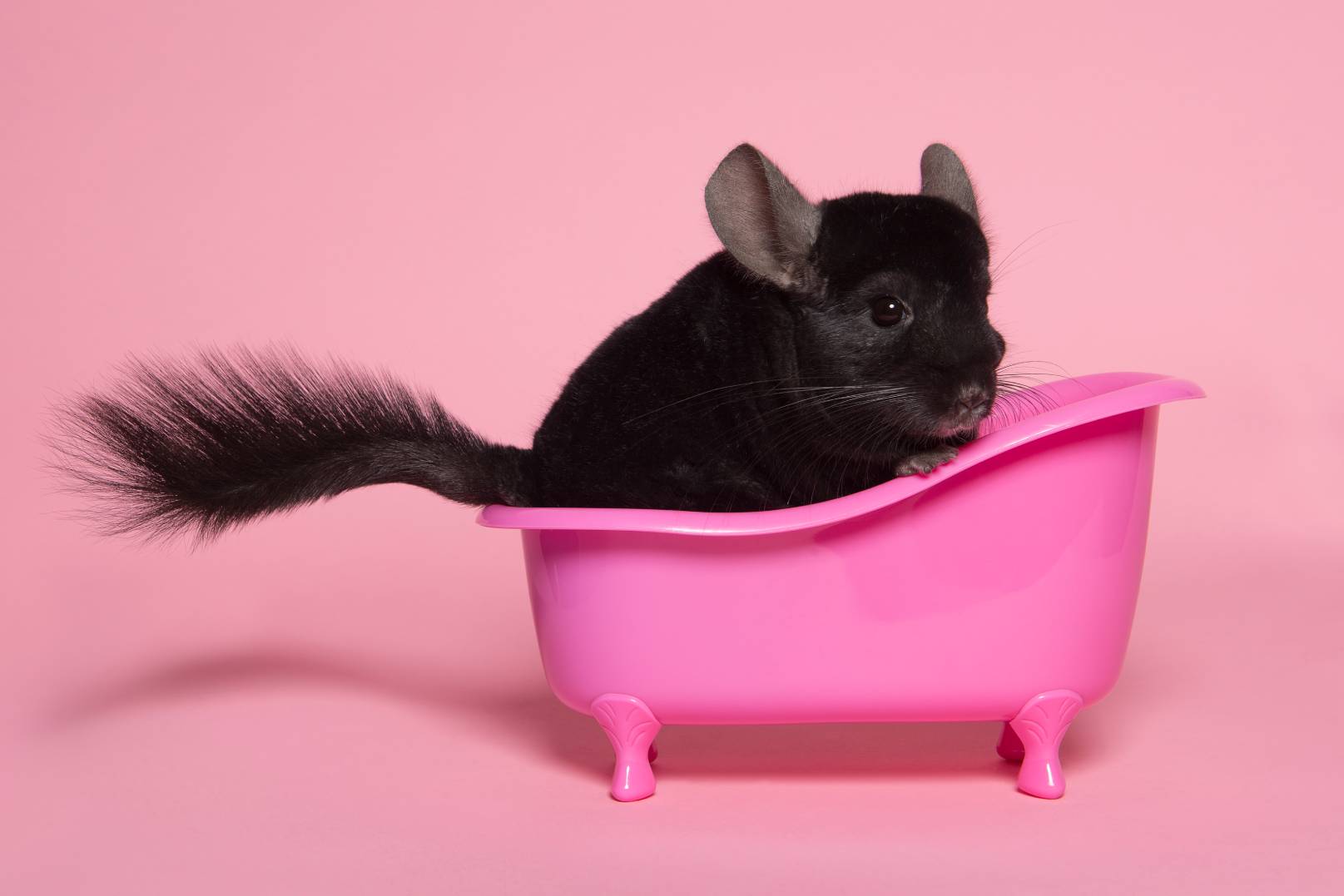
Health and Conditions
Chinchillas are relatively sensitive creatures. Besides never giving them water baths or allowing them to overheat, you have to manage their diet and keep them clean.

Male vs. Female
Females are often larger than male Chinchillas, but there is not much difference in their appearance or personality.
Final Thoughts
Adopting a Chinchilla is best to do from a breeder or a rescue shelter. They are an endangered species in the wild, but there are many domesticated Chinchillas. They need plenty of interaction and are a lifelong commitment for their human owners. If you want to adopt a Chinchilla, be prepared for their special diet and bathing needs to keep them healthy.
Featured Image Credit: Nynke van Holten, Shutterstock




